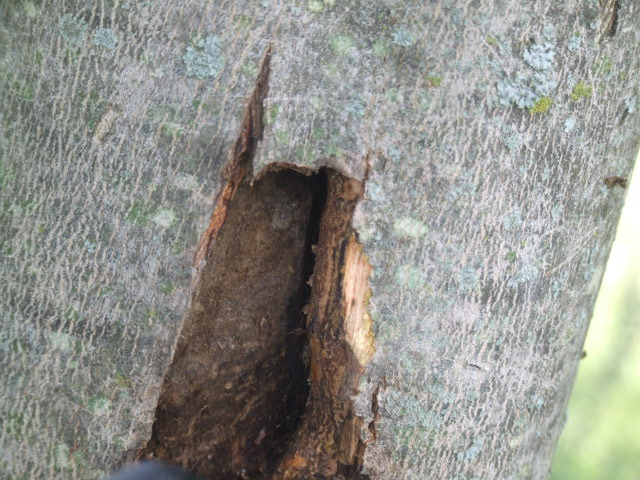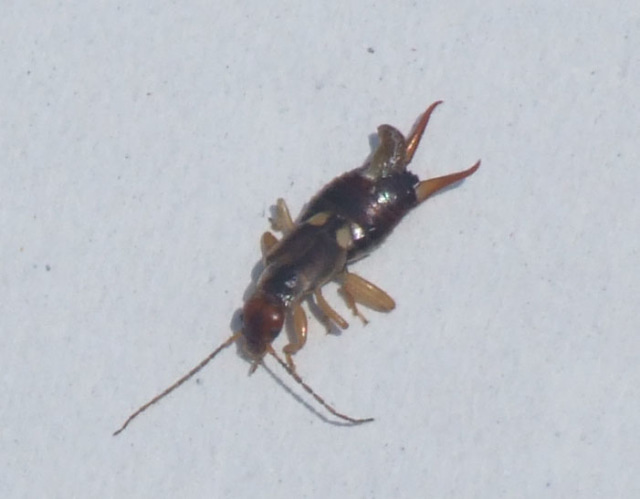Question Cracked Heartwood in A
Cracked Heartwood in A
 Autumn Blaze Maple Ins
Autumn Blaze Maple Ins
QUESTION: Hi Dr. Vann,
About 4 or 5 years ago I planted a couple of 3.5 inch caliper autumn blaze maples. In spring they sometimes get bark crack from freeze and thaw cycles that heals over in a season.
The one maple with a thickness of about 5.5 inches measured about six inches off the ground had an insect attack I noticed this spring. The insect ate all the inner bark in a 2 x 3 inch area. Behind the outer bark the tree was hollow.
I could see two holes the thickness of about one eighth to three sixteenths in the outer bark. The outer bark also cracked along the one side of the damaged area.
I stuck a small 4 penny nail sized stainless steel probe into the two holes to check on the depth of the damage. What looked like a black worm popped out the hole when I removed the probe. I ran into the house to grab the camera but the insect was gone when I returned. I removed the dead bark to expose an area 2 inches wide by 3 inches tall with missing wood and inner bark almost three quarters of an inch thick. The tree is trying to wall off the injured area.
On the right side of the damaged in the attached photo I hope you can see the crack into the hardwood of the inside of the tree. This crack goes upward above the damaged area of the wound. I am concerned something may be living farther up in the tree doing further damage?
Upon closer looking, I found two more smaller holes in the same tree about 30 inches lower on the tree trunk. I stuck a stainless steel hook probe into the hole and out came another insect. I tried to snap a photo which is attached.
The dark colored almost black insect has two antenna on its head, six much lighter tan to light brown legs, and two pinchers coming out of its back-end.
There were a pair of these insects in the hole. Both are dead with one in a jar on my desk and the other outside.
What is this insect and how do I stop if from further damage to this or other trees?
Thanks!
Mike
ANSWER: Mike:
This insect is an earwig. Probably the male. It uses the pinchers to grab a hold on to the female during reproduction.
These critters are of minor economic importance. More than likely, these and others have found a nice cozy spot in the decayed wood to set up housekeeping. The cracks in the bark are avenues by which decay fungal and bacterial organisms can enter. This is usually followed by a variety of insects. In many cases the insects are not the primary cause.
Keep in mind that this decayed area will be a weak area in the stem and may eventually cause the stem/trunk to fail, especially during high wind or when winter precipitation accumulates on the tree. Replacement may be your best option.
Regards
Steve
---------- FOLLOW-UP ----------
QUESTION: Hi Steve,
As my age is 54 years, a replacement tree will not grow enough to give the shading I desire in my lifetime. The preference is to keep this tree. Its 45 feet from my house so falling on the house will not be a concern in my lifetime.
What options are there to address the wound in the tree?
Could I apply some type of caulk to seal the crack in the inner wood? Is there a compounds like tree wax, cement, etc that I can use to fill the 2 inch by 3 inch void in the missing outer bark, the cambium, phloem missing layers?
My goal is to stop fungal infections and stop other insects from making this part of the tree trunk a home.
I appreciate any ideas you have to offer to seal this area.
Thanks
Mike
AnswerMike:
I appreciate your situation. Unfortunately, there is no "magic bullet" to reverse this decay process once it is started. This group of tree diseases are best controlled through prevention- especially wounds. String trimmers are among the worst enemies to shrubs and trees- almost a death sentence! For freeze/sunburn cracks, sometimes trunk wraps can help when applied before environmental conditions occur. Some varieties of thin barked trees (maples etc)are more prone to splitting than others. I hate to see those poorly adapted trees planted in a small island in the middle of a hot asphalt parking lot. The radiant heat from the paved area just cooks the bark. Poor selection choice here.
Promoting a vigorously growing tree is the best way to deal with situations as yours. Making sure the tree is fertilized and watered appropriately. Fertilization should be done based on a recent soil test that you can obtain through your county Agricultural Extension office. It will give you a detailed outline of the nutrient availability. Avoiding additional wounds can help too. A healthy tree can "wall off" to a certain extent the decayed area- that is slow down or even stop the process- but cannot reverse it.
I hope this information is of use to you and do hope your tree does well.
Steve







